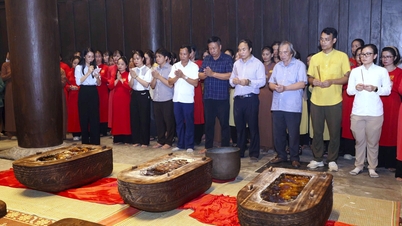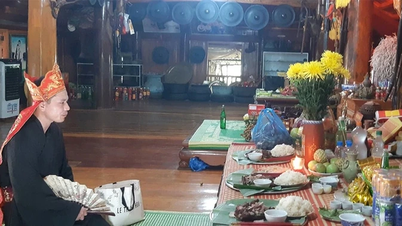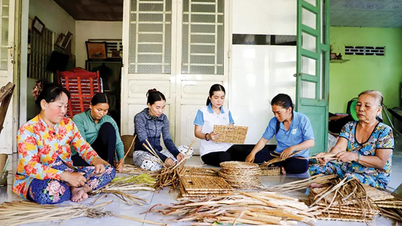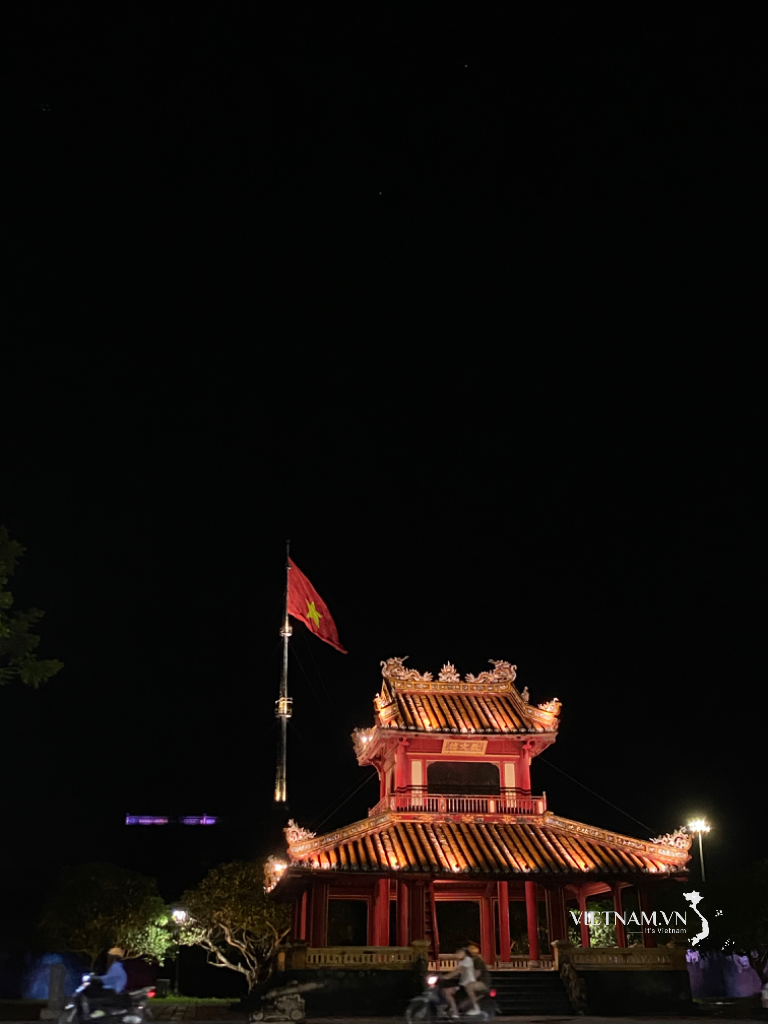(QBĐT) - Through many stages, with the skillful combination of carpenters from the old Diem Dien village, Duc Ninh Dong ward (Dong Hoi city) today with sophisticated mother-of-pearl and mother-of-pearl inlay workers, altar cabinets rich in aesthetic and artistic value have been created.
One day in September, I visited the home of Mr. Tran Van Vinh (63 years old) in Diem Trung residential group, Duc Ninh Dong ward to learn about his family's traditional altar cabinet making profession. From afar, I could hear the bustling sounds of saws and wood planers in the carpentry workshop next door...
Continuing the traditional profession
For Vietnamese people in general, Quang Binh people in particular, the placement of the altar and ancestral altar has an extremely important and sacred spiritual meaning. Therefore, the ancestral altar is always placed in the center, the most solemn place in every house. Choosing the altar and arranging the furniture on the altar is a place to express the respect and filial piety of the living to their ancestors, parents and the souls of the deceased.
According to Mr. Vinh, the profession of making altar cabinets has been with his family since his grandfather - a famous altar cabinet maker in the region. Because of his love for traditional carpentry and not wanting the profession to be lost, his grandfather passed on his love for the profession to his father, Tran Van Le. Also because of his love for the traditional altar cabinet making profession, his father pursued the profession until he was old and became famous in the region. Many people in neighboring localities such as Nghia Ninh, Duc Ninh, Le Ky village, Bao Ninh... came to order. Then, his father continued to pass on the profession to his three brothers; then his grandchildren... From his grandfather's generation until now, Mr. Vinh's family has had 4 generations specializing in making altar cabinets. Besides Mr. Vinh's family, many other families in the village also make altar cabinets.
 |
The profession of making altar cabinets requires workers to have very high skills. Many people are skilled carpenters, but when making altar cabinets, they are not as sharp and beautiful as those who specialize in making altar cabinets. To be able to make a beautiful altar cabinet, according to Mr. Vinh, the decisive factor is the skill of the carpenter and the mother-of-pearl and snail inlay workers. Previously, the stages of making altar cabinets were all done by hand, now with the support of machines and technology, it saves labor, progress, productivity and is faster; only the mother-of-pearl and snail inlay still has to be done by hand.
Keep the old spirit, old features
Wood for making altar cabinets is very diverse. In the past, jackfruit wood was quite popular, but later, craftsmen often choose precious, rare woods with high durability and beautiful wood grain such as lau wood, red wood, honey wood, and incense. If a house has the conditions, they will use rare and precious woods such as ebony, rosewood, and ironwood. These woods have a characteristic aroma, help repel insects, and bring a feeling of relaxation and comfort. But now the source of wood is increasingly scarce, South African woods such as stone incense, Pachi wood, etc. are used a lot. The selection of wood is also quite elaborate. The wood for making altar cabinets must be very dry, not warped, termite-free, and the three sides including the front, the top, and the two sides must be from the same piece of wood. Only then will the cabinet surface have the same wood grain and color. If many trees are chosen, the wood grain will be different. When assembled, the color and wood grain will be uneven, not beautiful, and the aesthetic value will not be high.
The process of making an altar cabinet goes through many stages: cutting wood, planing, smoothing, threading, mortising, carving, inlaying, assembling, cooling, and polishing. It can be said that the front of the cabinet is the soul, the place that shows the most quintessential beauty of the altar cabinet, so the craftsman always pays the most attention and invests the most effort. The front and two side frames, the skeleton must be planed with raised seams. The wood trim is also planed with raised seams, with light-colored woods such as mahogany and duong. The mortising method requires sharpness, meticulousness, and high precision. It is the light-colored lines, contrasting with the main skeleton and the dark surface that make up the unique part of the altar cabinet.
The front of the cabinet, usually has 13-17 sides, in some cases more sides. If the sides are sparse, the cabinet looks more spacious, if there are many sides, the cabinet's face is divided, looks messy, not airy. Therefore, the front of the cabinet with 15-17 sides will be chosen by many people. The surface is inlaid with mother-of-pearl, mother-of-pearl or embossed according to the needs and preferences of each homeowner. In the old village of Diem Dien, mother-of-pearl and mother-of-pearl inlaid altar cabinets are still the most popular.
The altar is decorated with patterns, motifs, peaceful, rustic, and rustic images of the Vietnamese countryside. The highlight of the altar is the skillful, sophisticated mother-of-pearl and mother-of-pearl inlays that occupy part of the surface of the altar. The mother-of-pearl inlays of Quang Binh craftsmen are not as sophisticated as those of the Northern craftsmen. The mother-of-pearl inlays on the front and sides of the altar are mainly statues of the three gods (Phuc, Loc, Tho), the four sacred animals (dragon, unicorn, turtle, phoenix), the four seasons (pine, chrysanthemum, bamboo, apricot), symbolic images of zither, chess, poetry and wine, banyan trees, village communal houses, mountains, woodcutters, bat faces, etc.
The highest part is usually the familiar image of two dragons facing the moon, the pedestal of the cabinet is two dragons facing the dragon looking in the front direction. The vertical and horizontal patterns of the cabinet frame are cloud patterns, flowers, leaves, and Chinese characters. The two sides of the cabinet are patterns of flowers, leaves, and scrolls.
The ingenuity, sharpness and meticulousness of the skilled inlay workers contribute to creating highlights for the products. The extremely sharp planing and mortising lines combined with the equally delicate inlay and carving artisans with many highly symbolic decorative motifs, clearly showing the traditional worldview and philosophy of life of the ancient Quang Binh people.
The altar cabinet is sprayed with glossy paint to preserve the beauty of the wood grain and to facilitate use. The altar cabinet surface is where the incense burner, worship photos, worship statues, fruits, incense burners, water, incense and lamps are placed. Regarding size, the width of the altar cabinet is calculated according to the straight ruler, that is, the ban ruler, suitable for the space of each house and the wishes of the homeowner. Normally, if the house is a stilt house, the width is about 1.26m, if the worship room is large, the size will be wider from 1.52-2.1m, the height is about 1.42-1.52m. The altar cabinet legs are often made in the style of kneeling or standing legs, the size must correspond to the size of the cabinet.
The ancient altar cabinet of Diem Dien village is truly a work of unique artistic quintessence, demonstrating the high skills of carpenters, contributing to preserving a bit of the old soul and features. The altar cabinet carries the cultural and historical features of the ancient land of Diem Dien, deeply ingrained in the subconscious of the people of Dong Hoi and the surrounding areas. The richness of style, design, the soft sophistication, the elegance of lines and colors really create a highlight, further enhancing the rustic, rustic beauty but also solemn and cozy, suitable for ancestor worship and the worship space in every Vietnamese home.
Nhat Linh
Source: https://www.baoquangbinh.vn/van-hoa/202410/nghe-dong-tu-tho-o-lang-diem-dien-xua-2221637/


![[Photo] Secret Garden will appear in Nhan Dan Newspaper's Good Morning Vietnam 2025 project](https://vphoto.vietnam.vn/thumb/1200x675/vietnam/resource/IMAGE/2025/9/19/cec307f0cfdd4836b1b36954efe35a79)
![[Photo] National Assembly Chairman Tran Thanh Man holds talks with Speaker of the Malaysian House of Representatives](https://vphoto.vietnam.vn/thumb/1200x675/vietnam/resource/IMAGE/2025/9/19/5cb954e3276c4c1587968acb4999262e)
![[Photo] Sea turtle midwives](https://vphoto.vietnam.vn/thumb/1200x675/vietnam/resource/IMAGE/2025/9/19/9547200fdcea40bca323e59652c1d07e)

![[Photo] Spreading Vietnamese culture to Russian children](https://vphoto.vietnam.vn/thumb/1200x675/vietnam/resource/IMAGE/2025/9/19/0c3a3a23fc544b9c9b67f4e243f1e165)














































































![[Infographic]: Sene Don Ta - a unique traditional cultural festival of the Khmer people](https://vphoto.vietnam.vn/thumb/402x226/vietnam/resource/IMAGE/2025/9/19/b61b6149a3034bd9b065fa67c0706c0b)




















Comment (0)